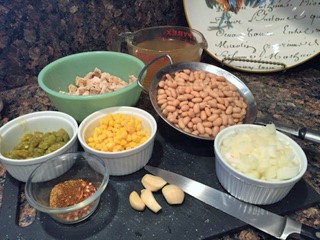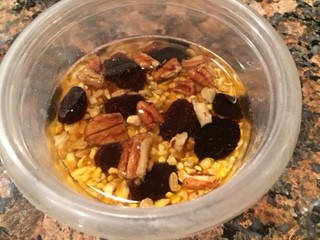Archive for January, 2016
Frugal Living – Reassess your Bills
January is the time when I get all my tax paperwork ready. It is also the time I reassess my bills, like utilities, water, trash, insurance, etc., to make sure I am getting the best possible deals. This can be different from region to region across the county. Find out if there are alternatives to utilities and review the costs. If you can get a better deal elsewhere, switch. If you have a landline, check to see if they have a bare bones price or cancel options you’re not using.
Check how many cell phone or internet data minutes you’re using. If you’re not using all of them switch to a cheaper plan. Review the channels you watch most often on cable and reduce your package to get rid of one’s you don’t watch or seldom watch.
Bundle your home and auto insurance, if it’s not already, and ask your agent how a higher deductable will effect your coverage and monthly bill.
Little changes made now can save you money all year long.
How to Roast the Perfect Chicken
There’s nothing better than a kitchen filled with the savory, satisfying aroma of a roasting chicken; at least in my opinion. It’s an important cooking skill too – roasting a bird that can eventually be made into 4 or 5 different meals. With just a few bought or homegrown onions, carrots and potatoes or parsnips, and a home raised or store bought broiler you’ll be on your way to a heart-warming meal the whole family will love. It’s easy, cheap and turns out wonderfully every time. It takes just a few minutes to prep and everything you need you probably already have on hand. Follow these simple instructions and I promise you’ll want to roast a chicken every week. I was taught this method by my father-in-law; one of the best meat cooks I know.
Here’s what you’ll need to roast the bird:
Whole roasting chicken
3 to 4 tablespoons, room temperature butter
Rosemary, garlic, and sage, chopped if fresh, crumbled if dry (or commercial poultry rub)
Tin foil
Roasting pan, without rack
Meat thermometer
1 medium onion, chopped
2 or 3 medium baking potatoes, peeled & quartered (parsnips can be added or substituted)
3 to 4 medium carrots, cut into chunks
These are the basics, but any seasonal veggie will do. Shake things up a bit by using yams, winter squash or summer squash, Brussels sprouts, or beets. Make it your own!
Preheat your oven to 400 degrees. I know that seems high, but you’ll see why in a minute.
Thaw frozen chickens in the fridge. Rinse thawed or fresh birds in cold water; making sure to rinse inside the cavity, under the wings and around the legs, then shake off excess water. Place your bird in a large bowl and take out your roasting pan. I use a 3-inch deep Calphon pan with high handles for easy lifting.
Chop the onions, carrots, potatoes or parsnips into chunks no large than 3- inches and spread them around the bottom of the pan. The veggies will act as a rack for the bird, letting air underneath so the bird cooks thoroughly as well as being cooked in the bird’s juices and fat. Drizzle the veggies with olive oil and sprinkle with salt and pepper or poultry rub. Set the roasting pan aside and go back to your bird-in-a-bowl.
Shake the bird again to get off any excess water and set it on a cutting board. Smear the bird all over with butter, making sure to get under the wings and around the legs. Gently slip your fingers under the skin that is over the breast and smear butter under the skin as well.
Now, take your finely chopped rosemary, garlic, sage or commercial chicken rub, and sprinkle them all over your bird. For a nice presentation on a serving platter, tie the drumsticks together with some kitchen string, and place the bird on top of your cut veggies.
Your buttery herb-rubbed chicken is ready for the oven.
Place the roasting pan on the center rack of your 400 degree oven. The flash of a hot oven followed by a slow roast will give the bird a luscious, crispy, golden skin. Let it crackle and pop for about 20 or 30 minutes before lowering the temp to 350. At this point you can cover the bird with foil which will keep it from scoarching the skin, but will allow it get crispy. I let mine cook undisturbed for an hour before taking it out to check for “doneness”. The skin should be a nice rich brown color and the internal temperature should be about 170 at the thickest part of the breast. I usually make a slice near the thigh to see if the juices run clear and not red or pink. If this happens just pop it back into the oven and recheck it every 5 to 10 minutes until it is done.
When you’re confident it’s done, pull the pan out and let it stand for about 15 or 20 minutes (the meat will continue cooking as it cools). As the bird cools, spoon the pan juices into a fat separator, pour off the juices into a small saucepan, add a tablespoon of butter and boil until reduced by about half. Taste and adjust the seasonings. Now you’re ready to slice the meat and serve it with a side of savory roasted veggies and a fabulous rich, herb infused gravy. Enjoy!
The leftovers from this easy roasted chicken make a great chicken salad, chicken sandwich, or chicken and rice casserole. And — don’t forget to simmer down the carcass (bones, skin and all) and pull off any remaining bits of meat for the best chicken soup base ever!
Learn to raise your own homegrown chicken with these helpful posts.
Raising Meat Chickens in Suburbia
Why Raise Chickens on a Suburban Homestead?
Frugal Friday – “Eating-In” from your Pantry
To reduce your grocery bill and save a few bucks after all that holiday spending, dedicate the next 10-days to eating out of your pantry. Take a day and prepare meals using what’s on-hand from your pantry and freezer. This is a great opportunity to use up freezer items you’ve had for a while and learn new recipes using just the ingredients you already have. Only shop for essential perishable items, like milk, eggs and produce (if you don’t already produce them yourself). You’ll not only save money, but also have a chance to inventory your pantry, creating a list of “to buy” items.
To extend your savings even more “eat-in” for another 10-days and watch the savings grow. You may even be inspired to not spend on other items, like clothing, toys, or entertainment.
How to Cook Crispy Brussels Sprouts
At our house, Brussels sprouts have become the quintessential winter vegetable. Those small, tightly bound, cabbage looking globes that most people hate happen to be our favorite. But, that wasn’t always the case. I wasn’t always this much in love, it came gradually over time. I can only describe my past views on the leafy orb as loathing. It wasn’t until I ate at an upscale restaurant in TN that the love affair began. The simple mix of olive oil and sea salt and the pan roasting made them taste amazing and convinced me that my prior judgments were unfounded.
On a cool fall day I set out to recreate the simple sprouts with olive oil and sea salt I had in TN. As usual I was doing too many things at once and got side tracked with God knows what because I forgot about my experiment. When the smell from the oven brought me back my little globes had “over-cooked” a bit, or so I thought. Being the frugal farmgirl that I am and not wanting to waste anything I popped one into my mouth to see if they could be salvaged. One right after the other they went into my mouth until I realized I had hit on something! They were browned, almost to the point of being caramelized, crispy with slightly blackened leaves, and the center was tender and meaty. That’s right…meaty.
A drizzle more of olive oil and another sprinkle of sea salt and we had hit the jackpot.
Below is my “go-to” way of roasting sprouts. But, don’t stop there. Brussels sprouts are the perfect canvas to creating many different flavors with spices, glazes, and sauces, whatever strikes your fancy.
Now—for one important point, they are a pain to prep. There…I said it.
It must be done, though, so get to it. Halve and peel the outer leaves. It shouldn’t take more than a few minutes to do a pound.
INGREDIENTS:
- 1 pound Brussels sprouts, washed, trimmed, halved and outer leaves removed
- 1 tablespoon olive oil, plus more for serving
- ½ teaspoon fine sea salt
- Fresh ground pepper to taste
DIRECTIONS:
Preheat oven to 400F and coat a large baking sheet with spray oil (preferably olive oil).
Use a paring knife to trim the ends, then slice in half lengthwise, remove any loose outer leaves.
Place prepped sprouts in a large bowl.
Add oil over sprouts and stir or toss with hands until thoroughly coated.
Add the salt and stir to combine.
Spread Brussels sprouts in a single layer on baking sheet. Season with freshly ground black pepper.
Roast at 400F on middle rack for 20 minutes then turn sprouts. Continue roasting for another 5-15 minutes until browned to your liking. To make them “crispy” and charred, brown a bit more than you think you should. This is where personal taste comes in. You may have to make a few batches to find your desired doneness. Keep in mind, smaller sprouts will brown faster than larger ones. Choosing sprouts the same size will help with this.
Before serving, drizzle with a teaspoon or so of olive oil and toss to coat. This will infuse them with flavor and moisten them a bit after roasting. Taste and add salt and pepper, if desired. Serve piping hot, immediately.
For variations on this recipe, try:
Adding a ½ teaspoon of Harissa spice blend to the above recipe
Sprinkling with grated Parmesan cheese before serving
Drizzling with pomegranate molasses or balsamic reduction before serving
Minced garlic cloves, garlic-infused oil, instead of the olive oil or garlic salt, instead of sea salt during the preparations
Drizzling with teriyaki sauce and sprinkling with sesame seeds before serving
Using BBQ sauce as a dipping sauce
Sprinkling toasted ground nuts, like pecans, or sesame seeds over the top
Or, use the recipe as a base and come up with your own creations. Brussels sprouts go well with spicy and hot seasonings, even hummus, so have fun experimenting.
Frugal Friday – Winter Heat Savings Tricks
25% of your houses heat can escape through windows and doorways, not to mention a few other sneaky places. Take steps now to close off the escape routes and save a bundle on your winter heating bill.
• Check door thresh holds and replace if they do not fit tight. If you can see daylight you’re losing heat…and money.
• Switch plates on outside walls are notorious for leaking heat because insulation is not installed close enough to stop the airflow. Remove the plate and fill small gaps around the box with an acrylic caulking. For larger gaps, use a foam sealant. Then, place a foam gasket over the outlet and reinstall the switch plate. This small investment will save you loads of heat from escaping and tons of money.
• Water lines, gas lines and cables that come into your house from an outside wall can also leak air and heat, plus they are entry points for bugs and mice. Seal with an expanding foam sealant to keep heat in and critters out. For water lines, slide back the metal ring around the pipe before you caulk. It’s purely decorative and won’t stop air escaping. Check yearly as the caulking can crack or peel off.
• If you work in or gather in one room most of the day use a space heater and turn down the thermostat. The rest of the house will be cool, but you’ll be toasty warm in the room you occupy.
• Use the sun to warm you and your house. If your work at home or are relaxing move furniture to a sunny window where the rays can keep you warm. Keep curtains open, especially on south facing windows to bring in more direct light and heat, and then close curtains at night to act as a barrier, keeping the warmth in.
Even in the middle of winter, you can slash your energy bills without sacrificing your comfort.
White Bean & Chicken Chili

I like chili. That thick spicy concoction that goes great with shredded cheese and sour cream or scooped with tortilla chips. It just says cold day, with a warm filling smile.
It was the perfect lambing season food when time was a luxury and we never really had time to sit down to a real multi-course meal. We could take it to the barn in a thermos and eat whenever we were in between ewes lambing. Life on a farm moves quickly and never rests so the humans can eat!
There are multiple ways to make chili–with beef, pork, chicken, even turkey. Over the years I have tried to experiment with different kinds and find an alternative to our old favorite to no avail. Not until this year, that is, when I stumbled on a chicken chili made with white beans, mild green chili’s, spices and corn. It’s the kind of bold richness in a bowl that chases away the cold weather screaming outside. And, we have needed to chase away a lot of cold windy weather lately.
I read over the recipe and made a few adjustments to the original to fit my style and I think it turned out great. The best part is you can make this chili on the stovetop for a quick to put together meal, or you can dump all the ingredients into a crockpot and let it meld all day long, coming home to a house filled with the aroma of chicken and chili’s. And, you can use leftover chicken (as I did) or use store bought rotisserie chicken. How easy is that!
Try it. I think you’ll like it!

INGREDIENTS:
- 2 (14.5-ounce) cans white beans, drained and rinsed
- 4 cups chicken broth
- 1 tablespoon avocado oil
- 1 large yellow onion, diced small
- 1 (8-ounce) can mild green chili’s
- 1 tablespoon cumin
- 1 generous teaspoon Penzey’s chili 9000
- 1/2 teaspoon red pepper flakes
- 4 garlic cloves, minced
- 1/2 teaspoon salt (more if needed)
- 4 cups cooked chicken, chopped or shredded (leftovers or rotisserie)
- 1 (14.5 ounce) canned corn, drained
- 1/4 cup fresh chopped cilantro
- 1 tablespoon fresh lime juice, plus more to taste
DIRECTIONS:
Using a stick blender, puree about 1 cup of beans with 1 cup of chicken broth and set aside.
Pour oil into a large pot or Dutch oven and heat over medium high. Add the onion and sauté until soft, about 4 minutes. Add the garlic and sauté for another minute. Add the spices and continue to cook, stirring frequently, for a minute so spices can toast. Add canned chili’s and stir for 1 minute. Add the chicken stock, puréed beans and 1/2 teaspoon of salt; bring to a boil. Reduce the heat to low and simmer, uncovered, for 20 minutes.
Stir in the chicken, whole beans, corn, cilantro and lime juice; bring to a simmer and cook for about 20 minutes. Taste and adjust salt and lime juice, if necessary. (The broth will look soupy — that’s fine, it will thicken up as it sits). Serve in individual bowls with a dollop of sour cream, crushed tortilla chips, and lime wedges.
On a side note: If you make this in a crockpot, combine all ingredients except for the cilantro. Add that about 1/2-hour before serving.
Another note: The chili thickens as it sits. If you make it ahead of time, you may need to add more broth to thin it out, but that’s your call. I like a thick chili.
Frugal Friday – Bits & Pieces Make Big Pots
Store small bits of leftover veggies, rice and meat in a sealed refrigerator or freezer container for later use. You know what I mean. Those small bits of leftovers that are not enough for a serving, even for one person.
At the end of the week or end of the month make a big pot soup or a vegetable stew. You’ll be surprised at how much you’ve gathered and what a hearty wholesome meal it will make. Add a salad and some crusty bread to round things out.
Do the same with leftover fruit and make yourself a yummy blended treat.
Did you know that 40% of all food in the U.S. goes to waste?
And, 90% of consumers throw food away while it is still edible?

Recent comments
Aenean nonummy hendrerit mauris. Phasellus porta.